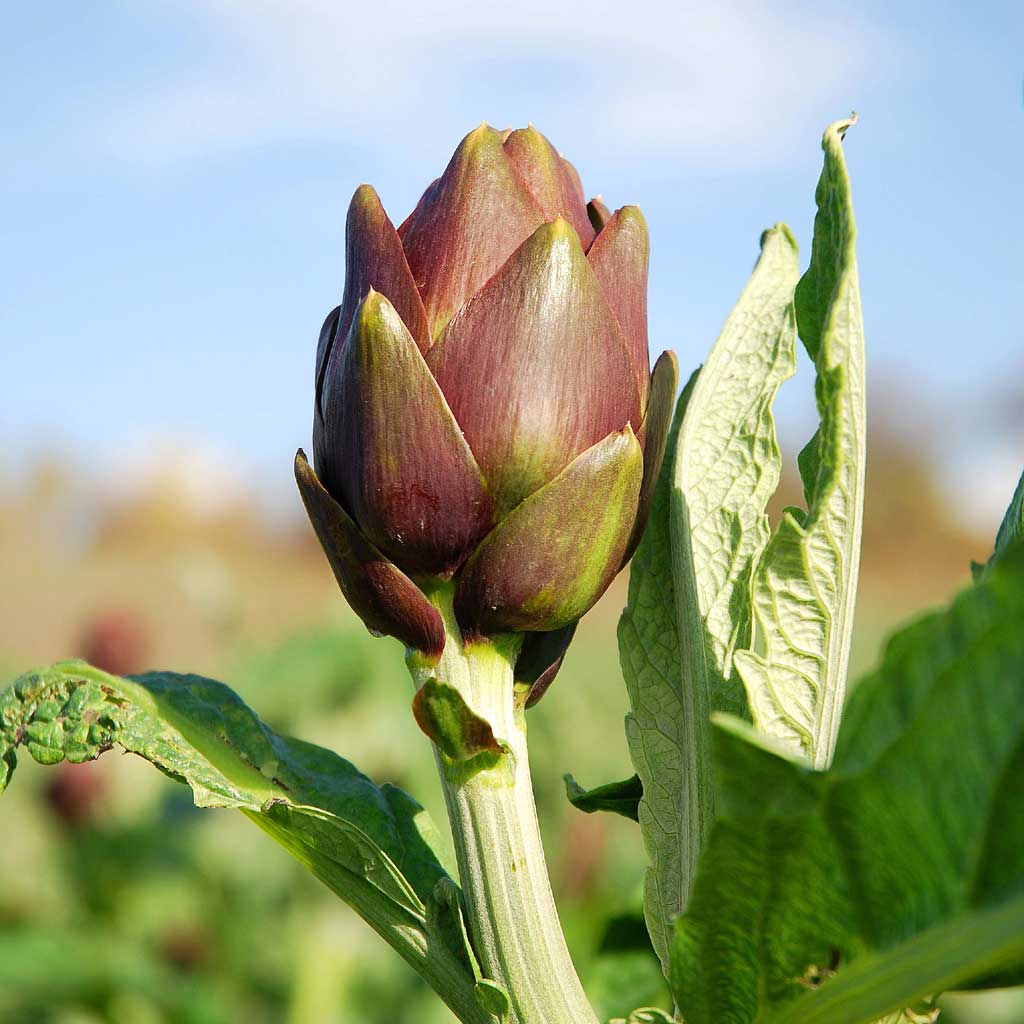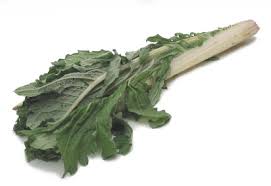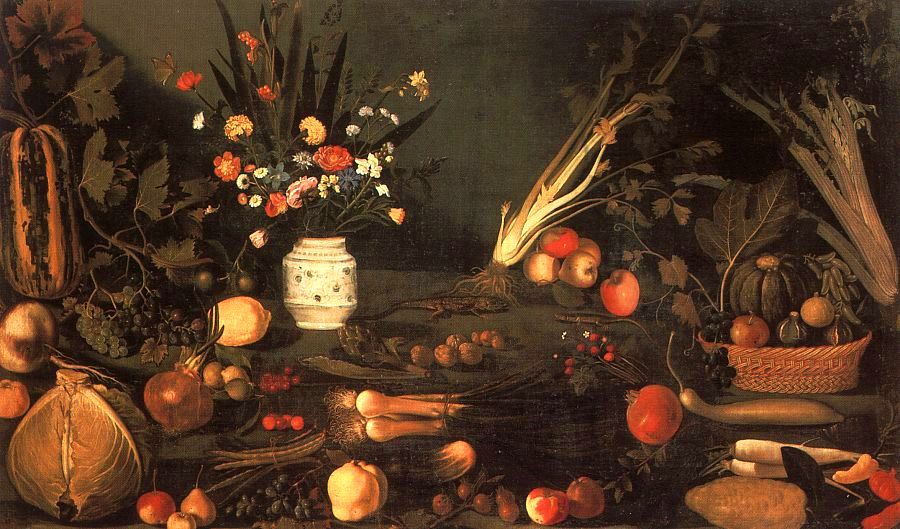
Cynara cardunculus belongs to the Asteraceae family and is native to the Mediterranean Basin.
It includes three botanical taxa:
*The globe artichoke (var. scolymus ): it is mostly vegetatively propagated and perennial
*The cultivated cardoon (var. altilis ) it is seed propagated and mostly grown as annual plant
*The wild cardoon (var. sylvestris)



Being a cross-pollinated diploid species (2n = 2x = 34) with proterandrous and asynchronous sexual maturity, C. cardunculus harbours a highly heterozygous genetic background.
It is a stout herbaceous plant growing to 0.8–1.5 m tall, with deeply lobed and heavily spined green to grey-green tomentose leaves up to 50 cm long, with yellow spines up to 3.5 cm long. The flowers are violet-purple, produced in a large, globose, massively spined capitulum up to 6 cm diameter.
Wild cardoon is the ancestor of both cultivated C. cardunculus forms which evolved independently under the influence of distinct anthropogenic selection criteria: globe artichoke for its immature inflorescences (capitula or heads), consumed either as fresh or industrial-processed product, while cardoon for its fleshy leaves.
| Kingdom | Plantae – Plants |
| Subkingdom | Tracheobionta – Vascular plants |
| Superdivision | Spermatophyta – Seed plants |
| Division | Magnoliophyta – Flowering plants |
| Class | Magnoliopsida – Dicotyledons |
| Subclass | Asteridae |
| Order | Asterales |
| Family | Asteraceae – Aster family |
| Genus | Cynara L. – cynara |
| Species | Cynara cardunculus L. – cardoon |
| Subspecies | C. c. subsp. altilis - C. c. subsp. sylvestris - C. c. subsp. scolymus |
HYSTORY
The domestication of globe artichoke and cultivated cardoon is not yet fully understood and when and where it occurred are still unknown.
Both Greek and Roman writers reported the consumption of this species, but classical literature records can be misleading. For instance, in ancient Greek the word scolymos relates to ‘spiny’ and this word might also refer to thistles other than C. cardunculus. Pliny the Elder in Naturalis historia writes that artichoke were cultivated in south Italy and south Spain. Columella in De re rustica reports on ‘cinara’ cultivation in Italy, but defines the plant ‘hispida’ (= spiny) and states that ‘pinea vertice pungit’ (= its head apex pierces).
Despite the positive role the Arabs had in the diffusion of artichoke, only the current names for this plant in Italian, Spanish and Portuguese (‘Carciofo’, ‘Alcachofa’, and ‘Alcachofra’, respectively) derive from the Arabic ‘al harshuff’. Interestingly, in English, French and German, as well as in northern European languages and Russian, the name of this plant comes from the late Latin/old Italian ‘Alcocalum’, ‘Articocalus’, ‘Articiocco’ or ‘Articoca’ of uncertain origin, but possibly related to the Latin ‘coculum’ (= cardoon), while in Greek the plant is known as ‘Aγγιναρα’ (= Agginara), which relates to old Greek ‘Kυoν’ (= Kyon, dog), possibly for spines recalling dog teeth. This strongly suggests that Italy was the bridge for the diffusion of artichoke in Europe.
The first certain records of artichoke commerce refer to Filippo Strozzi trading artichokes from Sicily to Florence in the early 15th century. Artichokes are also present in Renaissance paintings by Vincenzo Campi (1536–1591; L'ortolana, c. 1580) or Giuseppe Arcimboldo (1527–1593; L'estate, 1563; Vertumnus, 1590)


Old literature regarding the cultivated leafy cardoon is lacking, but this crop is present in painting at the beginning of the 17th century: in Caravaggio's Natura morta con fiori, frutta e verdure (uncertain dating, after 1600).

The fact that cultivated cardoons appear in Spanish and Italian paintings almost at the same time might relate to the fact that Spain dominated Italy starting from the mid-16th century (ending at the beginning of the 18th and mid-19th century in northern and southern Italy, respectively). It is interesting that the cultivated cardoon name in all European languages derives from the Latin ‘carduus’, which mostly relates to spininess.
ACTIVE MOLECULES DESCRIPTION
The current growing interest for natural antioxidants has led to a renewed scientific attention for artichoke, due not only to its nutritional value, but, overall, to its polyphenolic, showing strong antioxidant properties. The major constituents of artichoke extracts are hydroxycinnamic acids such as chlorogenic acid, dicaffeoylquinic acids, caffeic acid and ferulic acid, and flavonoids such as luteolin-7-glucoside and apigenin glycosides.






INDICATIONS
The therapeutic properties of Cynara cardunculus preparations have been known since ancient times. They include:
Antitumor effect : The human breast cancer cell line, estrogen receptor negative, MDA-MB231, was used to evaluate the antitumor effect of polyphenolic extracts from the edible part of artichokes (ALE).The addition of AEs to the cells triggered:
1) Apoptosis via a mitochondrial and a death-receptor pathway, as shown by the activation of caspase-9 and caspase-8, respectively
2) An increase of the Bax/Bcl2 ratio and up-regulation of cyclin-dependent kinase inhibitor, p21(WAF1)
3) A loss of mitochondrial transmembrane potential (Ψ(m))
4) A reduction of cell motility and invasion capabilities
5) A significant decrease of proteolytic activity of metalloproteinase-2 protein (MMP-2), involved in degrading components of the extracellular matrix.
Artichoke polyphenols induce apoptosis and decrease the invasive potential of the human breast cancer cell line MDA-MB231,2012
Anti-hypercholesterolemia effect: Universities of Exeter and Plymouth have made three randomized controlled trials with the objective to assess the evidence of ALE versus placebo or reference medication for treating hypercholesterolaemia defined as mean total cholesterol levels of at least 5.17 mmol/L (200 mg/dL).
* In one trial the total cholesterol level in participants receiving ALE decreased by 4.2% from 7.16 (0.62) mmol/L to 6.86 (0.68) mmol/L after 12 weeks and increased from 6.90 (0.49) mmol/L to 7.04 (0.61) mmol/L in patients receiving placebo, the total difference being statistically significant (P = 0.025).
* In a further trial ALE reduced total cholesterol levels by 18.5% from 7.74 mmol/L to 6.31 mmol/L after 42 +/- 3 days of treatment whereas the placebo reduced cholesterol by 8.6% from 7.69 mmol/L to 7.03 mmol/L (P = 0.00001).
* Another trial did state that ALE significantly reduced blood cholesterol compared with placebo in a sub-group of patients with baseline total cholesterol levels of more than 230 mg/dL (P < 0.05). Trial reports indicate mild, transient and infrequent adverse events.
Authors concluded that some data from clinical trials assessing ALE for treating hypercholesterolaemia exist. There is an indication that ALE has potential in lowering cholesterol levels, the evidence is, however, as yet not convincing. The limited data on safety suggest only mild, transient and infrequent adverse events with the short term use of ALE.
Artichoke leaf extract for treating hypercholesterolaemia,2009
Another study demonstrated that ALE could play a relevant role in the management of mild hypercholesterolaemia, favouring in particular the increase in HDL-C, besides decreasing total cholesterol and LDL-cholesterol.
The protective effects of fish oil and artichoke on hepatocellular carcinoma in rats,2011.
Antidyspeptic activity and choleretic activity: many studies show a significant increase in bile flow after acute treatment with ALE.
Choleretic activity and biliary elimination of lipids and bile acids induced by an artichoke leaf extract in rats,2002.
Cinarepa, a commercial mixture of dry extracts of artichoke leaf (Cynara scolymus) 15% of chlorogenic acid (150 mg per capsule), dandelion radix (Taraxacum officinalis) 2% of inulin, turmeric rhizome (Curcuma longa) 95% of curcumin and rosemary bud essential oil microencapsulated (Rosmarinum officinalis), was used during a trial regarding dyspepsia. The trial demonstrated a statistically significant gradual reduction in symptom severity at day 30 and further improvement was observed at day 60. Global clinical response, defined as a 50% reduction in the total scores of all symptoms, was recorded in 38% of patients at 30 days and in 79% at 60 days. At 60 days, total cholesterol, LDL and triglyceride levels had decreased by 6-8% over baseline values (P < or = 0.001); transaminase (AST, ALT), and gamma GT concentrations had diminished by 13-20 U/L (P<0.01) in patients with relatively elevated baseline values.
Phytotherapy with a mixture of dry extracts with hepato-protective effects containing artichoke leaves in the management of functional dyspepsia symptoms,2010.
In another trial, made by University of Reading, 247 patients with functional dyspepsia were recruited and treated with either a commercial ALE preparation (2 × 320 mg plant extract t.d.s.) or a placebo. The results were that the overall symptom improvement over the 6 weeks of treatment was significantly greater with ALE than with the placebo (8.3 ± 4.6, vs. 6.7 ± 4.8, P < 0.01). Similarly, patients treated with ALE showed significantly greater improvement in the global quality-of-life scores (NDI) compared with the placebo-treated patients (− 41.1 ± 47.6 vs. − 24.8 ± 35.6, P < 0.01).
Artichoke leaf extract (Cynara scolymus) reduces plasma cholesterol in otherwise healthy hypercholesterolemic adults: a randomized, double blind placebo controlled trial,2008
Against LDL oxidation: Artichoke extract retards LDL oxidation in a dose-dependent manner as measured by a prolongation of the lag phase to conjugated diene formation, a decrease in the rate of propagation and a sparing of endogenous LDL α-tocopherol during oxidation. Luteolin demonstrates an efficacy in inhibiting lipid peroxidation. Luteolin-7-O-glucoside, also demonstrates a dose-dependent reduction of LDL oxidation that is less effective than that of luteolin. Studies of the copperchelating properties of luteolin-7-O-glucoside and luteolin suggest a potential role for chelation in the antioxidative effects of artichoke extract.
Luteolin-rich artichoke extract protects low density lipoprotein from oxidation in vitro,1998
Against oxidative stress: Agueous and ethanolic extracts from artichoke were found to inhibit basal and stimulated ROS production in endothelial cells and monocytes in dose dependent manner. In endothelial cells, the ethanolic extract (50 microg/ml) reduced ox-LDL-induced intracellular ROS production by 60% (p<0,001) while aqueous extract (50 microg/ml) by 43% (p<0,01). The ethanolic extract (50 microg/ml) reduced ox-LDL-induced intracellular ROS production in monocytes by 76% (p<0,01).
Protective properties of artichoke (Cynara scolymus) against oxidative stress induced in cultured endothelial cells and monocytes,2001
Vascular NO production stimulation: Long-term incubation with a crude extract from artichoke leaves or its organic subfraction increased eNOS promoter activity, eNOS mRNA expression, eNOS protein expression, and NO production in cultured human vascular endothelial cells. Furthermore, long-term ex vivo incubation of aortic rings with the organic subfraction enhanced the endothelium-dependent, NO-mediated vasodilator response to acetylcholine.
NO synthesis can be modulated by eNOS activity and/or eNOS gene expression. Since short-term incubation with the artichoke extract had no effect on NO production in EA.hy 926 cells and did not change vascular tone of aortic rings, the effects of artichoke on endothelial NO synthesis seem to result mainly or exclusively from up-regulation of eNOS gene expression. Due to the antithrombotic, anti-atherosclerotic, and antihypertensive properties of endothelial NO, the eNOS enzyme could be an interesting target for the prevention or therapy of cardiovascular diseases. In vivo up-regulation of eNOS gene expression seems to be a reasonable and realistic strategy.
The artichoke extract OSF (organic subfractions of ALE), enriched in flavonoids and caffeoylquinic acids was more efficacious in stimulating eNOS expression than was the crude extract. The ASF, in contrast, contains only small amounts of these compounds and was without effect on eNOS expression.
Flavonoids from Artichoke (Cynara scolymus L.) Up-Regulate Endothelial-Type Nitric-Oxide Synthase Gene Expression in Human Endothelial Cells,2004
Xanthine oxidase (XO) inhibitory activity: The in vitro study showed that ALE inhibited XO with only minimal inhibitory action (< 5 %) at 100 microg/mL. However, when selected compounds were tested, the caffeic acid derivatives revealed a weak XO inhibitory effect with IC (50) > 100 microM. From the tested flavones the aglycone luteolin potently inhibited XO with an IC (50) value of 1.49 microM. Luteolin 7-O-glucoside and luteolin 7-O-glucuronide showed lower XO inhibition activities with IC (50) values of 19.90 microM and 20.24 microM, respectively. However, oral administration of an aqueous ALE, luteolin, and luteolin 7-O-glucoside did not produce any observable hypouricemic effects after acute oral treatment in potassium oxonate-treated rats. After intraperitoneal injection of luteolin a decrease in uric acid levels was detected suggesting that the hypouricemic effects of luteolin are due to its original form rather than its metabolites produced by the gut flora.
Flavonoids of Cynara scolymus possess potent xanthinoxidase inhibitory activity in vitro but are devoid of hypouricemic effects in rats after oral application,2008
Inhibition metalloproteinase 9: . A fully characterized Cynara cardunculus extract is able to inhibit, in a dose-dependent manner, the gelatinolytic activity of secreted MMP-9 and both secretion and human MMP-9 promoter-driven transcription. Testing a mix of the individual components suggestes that the inhibitory effects of Cynara cardunculus are due to minor constituent fraction(s) as a whole.
Mediterranean diet and cardioprotection: wild artichoke inhibits metalloproteinase 9,2008.
DOSAGE RACCOMANDATION:
Substantiation exists for the following conditions:
*Choleretic properties: 200-250 mg three times a day.
*Cholesterol and triglycerides reduction: 60-1500 mg a day.
*Irritable Bowel Syndrome: 320-1920 mg a day
TOXICITY
No major adverse reactions or toxicity has been reported in animal or human models